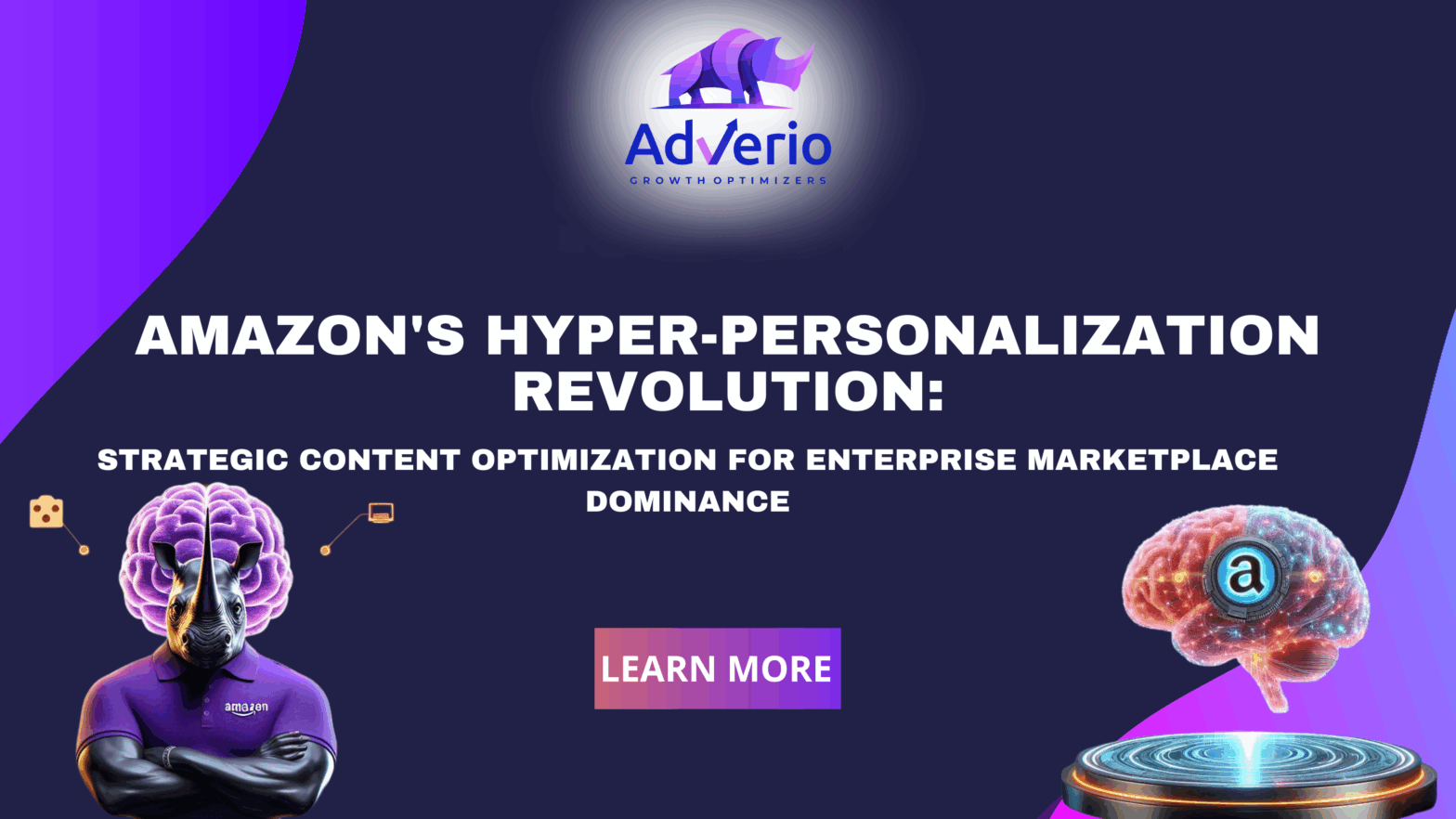Discover how sophisticated ecommerce operators leverage Amazon’s AI-driven personalization algorithms to optimize conversion infrastructure and maximize visibility across diverse customer segments through intent-based content strategies.
Amazon’s search ecosystem has fundamentally transformed from static keyword matching to dynamic, AI-powered personalization engines. For enterprise marketplace operators managing 7-8 figure portfolios, this algorithmic evolution represents both strategic opportunity and operational complexity requiring systematic content optimization approaches.
This tactical analysis examines Amazon’s hyper-personalization infrastructure and provides actionable frameworks for sophisticated brands seeking to maximize visibility across personalized search experiences.
Table of Contents
The Algorithmic Shift: From Universal Rankings to Contextual Relevance
Amazon’s personalization engine now processes over 25 years of behavioral data through advanced AI systems, including the Rufus shopping assistant, to deliver individualized search experiences. The platform analyzes purchase history, browsing patterns, seasonal context, and real-time intent signals to customize product discovery for each user interaction.
Critical Performance Implication: Traditional ranking metrics become obsolete when every shopper experiences different search results. Share of Voice (SOV) and universal keyword positioning lose strategic relevance as Amazon’s AI creates millions of micro-algorithms one for each unique customer profile and query context.
Personalization Data Points Amazon Leverages:
- Historical purchase behavior and category preferences
- Search query patterns and semantic intent analysis
- Engagement metrics including dwell time and click-through patterns
- Seasonal and geographic context for temporal relevance
- Cross-category behavioral correlations for predictive matching
Strategic Insight: Amazon’s research indicates 39% of search queries demonstrate high seasonal variability, creating dynamic ranking opportunities for brands that optimize for contextual relevance rather than static keyword density.
Competitive Implications: Beyond Amazon’s Ecosystem
This personalization trend extends across major marketplace platforms. Walmart’s AI-guided search initiatives and Target’s data-driven discovery features signal industry-wide adoption of customer-centric algorithms. Enterprise operators must prepare for personalized shopping experiences becoming the marketplace standard, not Amazon’s unique differentiator.
Market Intelligence: Flywheel’s analysis confirms that AI-driven search is “eliminating the significance of organic rank driven by single scrapes,” forcing sophisticated operators to develop new performance measurement frameworks and optimization strategies.
Strategic Framework: Intent-Driven Content Architecture
Rather than viewing personalization as algorithmic uncertainty, advanced operators should recognize it as Amazon’s directive toward buyer-centric optimization. Brands demonstrating deep customer understanding through contextual content will achieve superior visibility across diverse personalized experiences.
Core Optimization Principles:
Semantic Relevance Over Keyword Density: Amazon’s AI prioritizes intent matching over exact keyword repetition. Products that authentically address shopper needs within specific contexts achieve higher algorithmic preference than those optimized for generic search terms.
Multi-Context Content Strategy: Single products must appeal to multiple buyer personas and use cases. Strategic content architecture addresses various customer intents within unified listing frameworks, maximizing personalization algorithm compatibility.
Tactical Implementation: Advanced Content Optimization Protocols
-
Intent-Based Keyword Architecture
Beyond Traditional Research: Move from volume-based keyword targeting to intent-mapping strategies. Incorporate long-tail phrases and natural language patterns that reflect genuine customer problem-solving queries.
Strategic Example:
- Traditional: “wireless headphones”
- Intent-based: “noise-canceling headphones for remote work productivity”
- Advanced: “comfortable over-ear headphones for 8-hour workdays”
Implementation Protocol:
- Analyze search term reports for intent pattern identification
- Leverage Amazon’s autocomplete suggestions for semantic variations
- Mine customer review language for authentic problem articulation
- Deploy natural language processing for query intent classification
-
Context-Rich Product Architecture
Title Optimization Strategy: Construct product titles that communicate functional benefits within specific use contexts, moving beyond feature enumeration to solution positioning.
Bullet Point Framework: Transform feature lists into benefit-driven narratives that address customer questions and connect product capabilities to real-world applications.
Strategic Template:
- Feature: “Waterproof to 50 meters”
- Context-rich: “Waterproof to 50 meters engineered for swimming, surfing, and shower use without device removal”
Advanced Implementation:
- Address the “why” behind customer searches
- Connect technical specifications to practical applications
- Anticipate and answer unspoken customer concerns
- Layer multiple use cases within single content blocks
-
Visual Intent Communication
Image Strategy Evolution: While Amazon’s AI primarily processes text, visual content serves crucial conversion and customer communication functions within personalized experiences.
Advanced Visual Tactics:
- Context demonstration: Show products in relevant use environments
- Problem-solution imagery: Visually address common customer concerns
- Comparison photography: Enable quick decision-making for different buyer personas
- Seasonal adaptability: Rotate imagery based on temporal relevance
Technical Implementation:
- Deploy text overlays addressing specific customer questions
- Optimize alt-text for contextual keyword integration
- Create lifestyle imagery for multiple customer segments
- Maintain Amazon compliance while maximizing contextual communication
-
Enhanced Content (A+) Optimization
Strategic A+ Content Framework: Leverage Enhanced Brand Content as comprehensive customer education and persona targeting infrastructure.
Modular Content Strategy:
- Comparison matrices for different buyer segments
- Use case galleries demonstrating product versatility
- Seasonal modules addressing temporal customer needs
- Technical specifications with practical application context
Advanced Tactics:
- Create persona-specific content sections
- Address competitive differentiation proactively
- Develop seasonal content rotation strategies
- Implement FAQ-style modules anticipating customer concerns
-
Social Proof Optimization
Review Strategy Enhancement: Transform customer feedback into algorithmic intelligence and conversion optimization tools.
Strategic Review Management:
- Encourage detailed, context-rich customer testimonials
- Highlight reviews demonstrating diverse use cases
- Respond strategically to Q&A for comprehensive information coverage
- Leverage review insights for continuous content optimization
Implementation Framework:
- Monitor review sentiment for content gap identification
- Pin strategic reviews showcasing key benefits
- Maintain active Q&A engagement for information completeness
- Use customer language for authentic content development
Performance Analytics: Measuring Personalized Success
Traditional marketplace metrics require evolution for personalized algorithm environments:
Advanced KPIs for Personalized Performance:
- Conversion rate optimization across customer segments
- Customer acquisition cost efficiency by buyer persona
- Engagement metrics including time-on-listing and scroll depth
- Cross-category performance correlation for portfolio synergies
- Seasonal performance patterns for temporal optimization
Strategic Measurement Framework:
- Segment-specific attribution rather than universal rankings
- Intent-based conversion tracking for optimization insights
- Customer journey analytics for personalization impact assessment
- Competitive visibility analysis across diverse customer profiles
Continuous Optimization Protocol
Agile Content Management: Personalized algorithms require dynamic content strategies with regular optimization cycles based on performance data and seasonal trends.
Strategic Implementation Schedule
Monthly Reviews:
- Performance metric analysis across customer segments
- Seasonal content adjustment for temporal relevance
- Competitive positioning assessment within personalized results
Quarterly Optimization:
- Complete content audit for intent alignment
- A+ Content refresh for emerging customer needs
- Keyword strategy evolution based on algorithm updates
Annual Strategic Planning:
- Comprehensive personalization impact assessment
- Portfolio-wide optimization strategy refinement
- Technology integration planning for emerging AI features
Strategic Partnership Advantage
Navigating Amazon’s hyper-personalization requires sophisticated content strategy, continuous optimization protocols, and advanced analytics interpretation capabilities that demand specialized marketplace expertise.
At Adverio, we help enterprise marketplace brands develop and execute personalization-optimized content strategies that maximize visibility across diverse customer segments. Our systematic approach integrates intent-based optimization with comprehensive performance analytics and continuous refinement protocols.
Ready to dominate personalized marketplace algorithms?
Schedule a Personalization Strategy Consultation →
Our marketplace strategists will audit your current content architecture, identify personalization optimization opportunities, and design custom frameworks that ensure maximum visibility across Amazon’s AI-driven discovery experiences. Transform algorithmic complexity into competitive advantage through strategic content optimization that scales across your entire product portfolio.




























